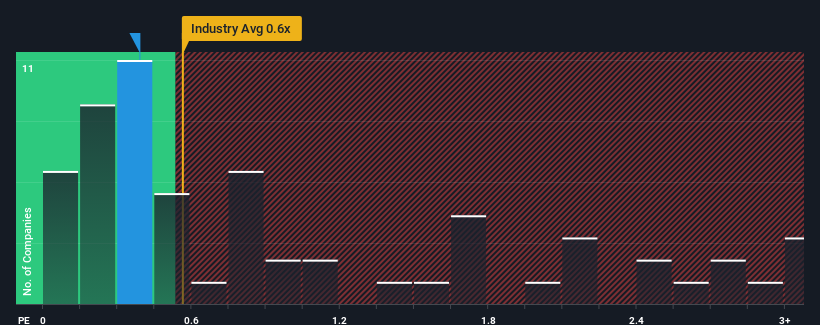AustAsia Group Ltd. (HKG:2425) Might Not Be As Mispriced As It Looks
There wouldn't be many who think AustAsia Group Ltd.'s (HKG:2425) price-to-sales (or "P/S") ratio of 0.4x is worth a mention when the median P/S for the Food industry in Hong Kong is similar at about 0.6x. While this might not raise any eyebrows, if the P/S ratio is not justified investors could be missing out on a potential opportunity or ignoring looming disappointment.
See our latest analysis for AustAsia Group

What Does AustAsia Group's Recent Performance Look Like?
AustAsia Group has been doing a good job lately as it's been growing revenue at a solid pace. One possibility is that the P/S is moderate because investors think this respectable revenue growth might not be enough to outperform the broader industry in the near future. If you like the company, you'd be hoping this isn't the case so that you could potentially pick up some stock while it's not quite in favour.
Although there are no analyst estimates available for AustAsia Group, take a look at this free data-rich visualisation to see how the company stacks up on earnings, revenue and cash flow.How Is AustAsia Group's Revenue Growth Trending?
In order to justify its P/S ratio, AustAsia Group would need to produce growth that's similar to the industry.
If we review the last year of revenue growth, the company posted a worthy increase of 7.8%. This was backed up an excellent period prior to see revenue up by 60% in total over the last three years. Accordingly, shareholders would have definitely welcomed those medium-term rates of revenue growth.
When compared to the industry's one-year growth forecast of 9.3%, the most recent medium-term revenue trajectory is noticeably more alluring
In light of this, it's curious that AustAsia Group's P/S sits in line with the majority of other companies. It may be that most investors are not convinced the company can maintain its recent growth rates.
The Bottom Line On AustAsia Group's P/S
We'd say the price-to-sales ratio's power isn't primarily as a valuation instrument but rather to gauge current investor sentiment and future expectations.
We've established that AustAsia Group currently trades on a lower than expected P/S since its recent three-year growth is higher than the wider industry forecast. When we see strong revenue with faster-than-industry growth, we can only assume potential risks are what might be placing pressure on the P/S ratio. It appears some are indeed anticipating revenue instability, because the persistence of these recent medium-term conditions would normally provide a boost to the share price.
There are also other vital risk factors to consider before investing and we've discovered 2 warning signs for AustAsia Group that you should be aware of.
It's important to make sure you look for a great company, not just the first idea you come across. So if growing profitability aligns with your idea of a great company, take a peek at this free list of interesting companies with strong recent earnings growth (and a low P/E).
New: Manage All Your Stock Portfolios in One Place
We've created the ultimate portfolio companion for stock investors, and it's free.
• Connect an unlimited number of Portfolios and see your total in one currency
• Be alerted to new Warning Signs or Risks via email or mobile
• Track the Fair Value of your stocks
Have feedback on this article? Concerned about the content? Get in touch with us directly. Alternatively, email editorial-team (at) simplywallst.com.
This article by Simply Wall St is general in nature. We provide commentary based on historical data and analyst forecasts only using an unbiased methodology and our articles are not intended to be financial advice. It does not constitute a recommendation to buy or sell any stock, and does not take account of your objectives, or your financial situation. We aim to bring you long-term focused analysis driven by fundamental data. Note that our analysis may not factor in the latest price-sensitive company announcements or qualitative material. Simply Wall St has no position in any stocks mentioned.
About SEHK:2425
AustAsia Group
Produces and sells raw milk, beef cattle, and feed products in Mainland China.
Slightly overvalued with imperfect balance sheet.
Market Insights
Community Narratives



